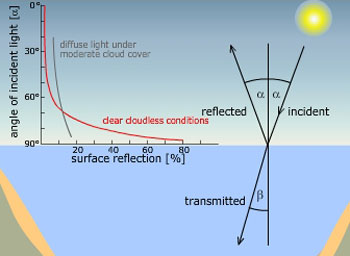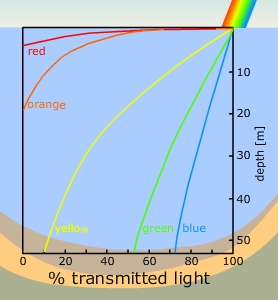 |
|
|
|
|
|
|
|
Reflection at the water surface |
|
A significant portion of incident radiation is reflected at the surface. This reflectivity depends on the angle of incidence, the wavelength of the incident light and the surface (ice cover, waves) of a lake. Blue light is reflected to a slightly greater extent than light of lower frequencies. The graph depicts surface reflection as percentage of total solar radiation at varying angles of incidence. In contrast to a clear, cloudless day (red curve), reflection of diffuse light under moderate cloud cover is much lower (gray). |
1 - Surface reflection at varying angles of light incidence |
|
Transmission of light in water |
|
The light intensity Iz at depth z is a function of surface irradiance (I0) and the extinction coefficient (e): Iz = I0 ·e-ez The extinction coefficient itself is wavelength-dependent: eIR > ered > eorange > eyellow > egreen > eblue The natural total extinction coefficient (etot) depends on the absoptive properties of water itself (ew), the absorption and scattering by suspended particles (ep) and by dissolved colored compounds (ec) (also pigmented organisms): etot = ew + ep + ec |
2 - Transmitted light of various wavelengths |
29 August 2011 |
||
| |
||

